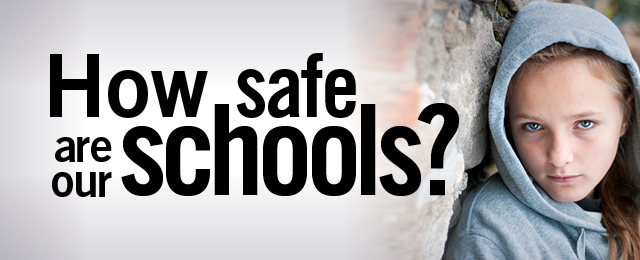Ready for trouble
The noon break draws to a close on a sunny February day at Clarence Fulton Secondary School in Vernon. The hallways are full of life. Fulton cheerleaders are packing up and counting profits from their Valentine’s Day cupcake sale in the bright school atrium. Groups of students wander in, snow still on their boots, heading for classes. Laughter and chatter fill the air as 800 students settle in for the afternoon.
Suddenly an air horn blasts from the PA.
Silence.
The next sound is the voice of principal Malcolm Reid reading from a standard script, part of strict district protocol.
“Attention all staff and students. This is a Level 1 lockdown. For security reasons, teachers please check the hallway for staff and students and direct them to a classroom and then lock your classroom door immediately.” Silent pause; Reid repeats the message.
In classrooms students hand in cell phones and huddle in previously designated corners not visible from windows while teachers lock doors and turn out lights.
In less than 30 seconds an eerie silence engulfs the building. Reid, vice-principal Jeff Huggins, head custodian Barry Jackson and RCMP school liaison officer (SLO) Kathy Szoboticsanec stride silently along the dim deserted hallways, rattling door handles to check locks and peering into rooms to ensure that no one can be seen.
Back in the office two more announcements end the drill. Teachers and the SLO debrief with students. At the end of the day the principal will provide feedback on what could be done differently next time.
This was a drill, but students and staff know lockdowns are serious business.
New school culture
“Lockdown drills have quickly become a part of school culture,” says Reid. “The original anxiety of parents and students that occurred when we started drills about six years ago is no longer there.”
“At first, students didn’t want to surrender their cell phones,” says SLO Szoboticsanec, “but when we took the time to explain the dangers of uncontrolled information leaking out in a real disaster, they understood. Now, there’s no problem.”
Most districts require three lockdown drills a year in each school, but none should be a complete surprise. “Lockdown drills can be quite unnerving for some students and traumatic for others,” says Rod Baruta, principal of Kelowna’s Dr. Knox Middle School. “You have to weigh the benefits. The main thing is that the students know the procedure.”
And take it seriously. “We practice enough times so that we’ll remember what to do without questions or problems,” says Alexandra, a Grade 10 student at Vernon Christian School. “When we perform any drill, real or practice, I’m glad to know that we’ll take care of one another to make sure no one gets hurt or makes a wrong decision.”
“We know about Columbine and Taber and the seriousness of what could happen,” says Laura, a Grade 12 Fulton student.
“It’s nice to know we’re all on the same page to know what we have to do,” adds a fellow student, Taylor.
Multiple Threats
Lockdown in the face of possible violence is just one of a myriad of potential critical incidents. The BC Ministry of Education requires that all schools have emergency planning and critical incident response protocols in place to deal with a variety of crisis situations.
Sometimes rapid, efficient evacuation is called for. “All schools have at least five fire drills a year, often a surprise, and up to three earthquake drills as well as the lockdowns,” says Don Wilcox, director of instruction – student support services for School District 22.
Critical incidents create strong emotional responses in both students and staff. The existence of well-established plans for dealing with the situation can reduce confusion and ensure that decisions are reasoned and thorough. When an incident occurs, there is often little time for reflective decision-making.
“That’s why plans have to be practiced and in place at all times,” says Alan Lalonde, principal of central programs and services for School District 23 and chair of the district safe schools committee. “Protocols are updated yearly, posted in all classrooms and offices at schools sites, on a restricted website and available on iPhone for administrators.”
He adds, “You can always practice more, but the biggest challenge is how to act appropriately, to use common sense, to stay calm. At superintendents’ meetings we experience simulation exercises and discuss what might be done to handle scenarios at each school.”
Procedures and Practice
Each district hosts an inter-agency safe schools committee. Among the goals are providing a venue to voice concerns, increasing public awareness of safety issues, formulating recommendations for schools and community members and reviewing models and research related to school and community safety.
Procedures to deal with all emergencies and to respond after an incident must be well-established and practiced long before a crisis occurs. To help prepare, Vernon, the Central Okanagan and North-Okanagan Shuswap have joined forces with partners such as the RCMP and various other community stakeholders to bring in Canadian expert J. Kevin Cameron of the Canadian Center for Threat Assessment and Trauma Response.
In concert with the RCMP behavioural sciences unit, Cameron developed Canada’s first multidisciplinary threat assessment training program. “All district and school based administrators, counsellors and SLOs have completed Level 1 threat assessment training and many, also Level 2,” says Wilcox. “The cooperation of agencies is exceptional here. We have a marvellous working relationship.”
Sessions introduce the new field of student threat assessment, offering insight into known school shooters and other violent youth, and helping districts and schools develop protocols for threat/risk assessment intervention teams.
Various other experts from agencies like Interior Health and the Ministry for Children and Families have been brought in to guide districts and schools in forming critical incident response teams.
Wilcox says there are district teams in place for both threat assessment and crisis response and trained personnel at every high school, usually the administrator and counsellor. Elementary school administrators are also trained and there is a counsellor shared among four schools. “Expertise is available at every school site and district response teams can be sent in to support and assist.”
Communications Hurdles
In a real emergency efficient communication is paramount. While administrators have cell phones supplied by their district, classroom teachers do not. There is a great variety of communication systems, depending on the age of the school building,
Most have public address systems so that messages can be broadcast from the office to all rooms. However, the way teachers are able to communicate back to the office is another story.
“Most depend on the intercom (public address) system and the fire bell,” says Alice Rees, president of the Central Okanagan Teachers’ Association.
Kevin Epp, past president of the Okanagan-Skaha Teachers’ Union, considers the situation to be grossly inadequate. “Most classrooms have intercom at best, and it may or may not have someone monitoring in the event of a crisis. As well, in the case of a disaster the system may not function. There are many classrooms that have no other means of communication. In the event of emergencies in the classroom, teachers are left with no other means but running to the office or having students run to the office to get help.”
Relatively new schools like Dr. Knox Middle School boast up-to-date communication technology. Principal Baruta can use the public address system or call any room using a four-digit number. Teachers can respond in kind. Such luxuries are not yet in place in all Okanagan schools.
The RCMP has copies of all school emergency plans as well as aerial photos, blueprint plans and designated evacuation site meeting points for most high schools. These can be brought up on the computer in squad cars. “We have been working on this for the past three years and still have to provide this information for the Coldstream area and all elementary schools,” says Wilcox. Modifications and alterations to all schools are updated annually.
Coordinated Efforts
As well as RCMP, fire and ambulance services, backup and coordination support are available from teams like North Okanagan Emergency Management. “For school emergencies, ESS (emergency support services) is the support and the school district is the lead agency,” says Helen Sinclair, deputy emergency support services coordinator.
“For instance, in the event of a school bus accident, we would work with fire and ambulance onsite to immediately register families affected (schools would later follow up) and provide a crisis line for mental health support for families to assist the school district crisis response team and assist with the media control component,” she says. “In the event of an evacuation of a neighbourhood surrounding a school, we can set up a reception centre, register people and take care of students, families and others who cannot return home.”
Sinclair says, “School, home or community, we can lessen the impact of a disaster if we work together and are prepared.” ~Patti Shales Lefkos




0 Comments